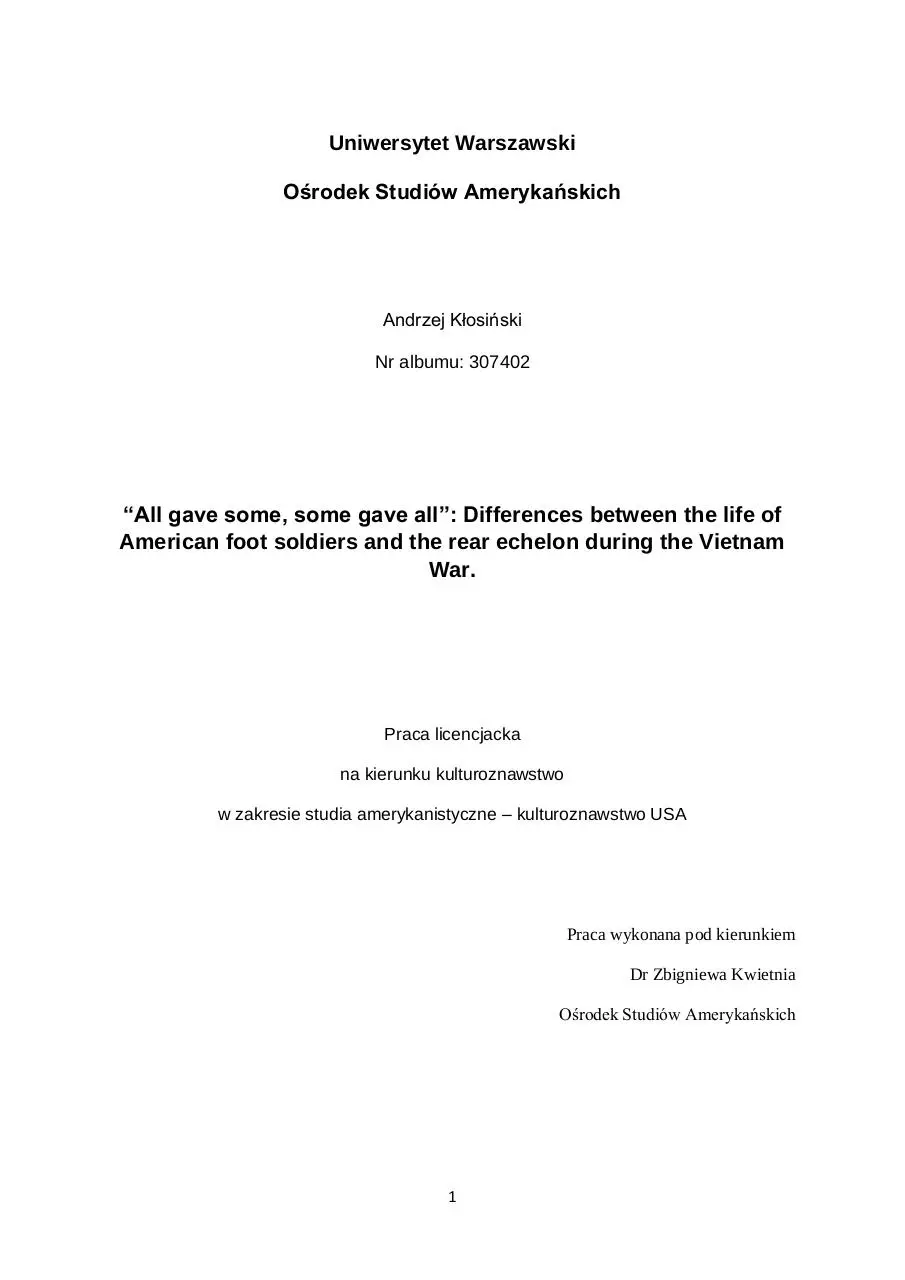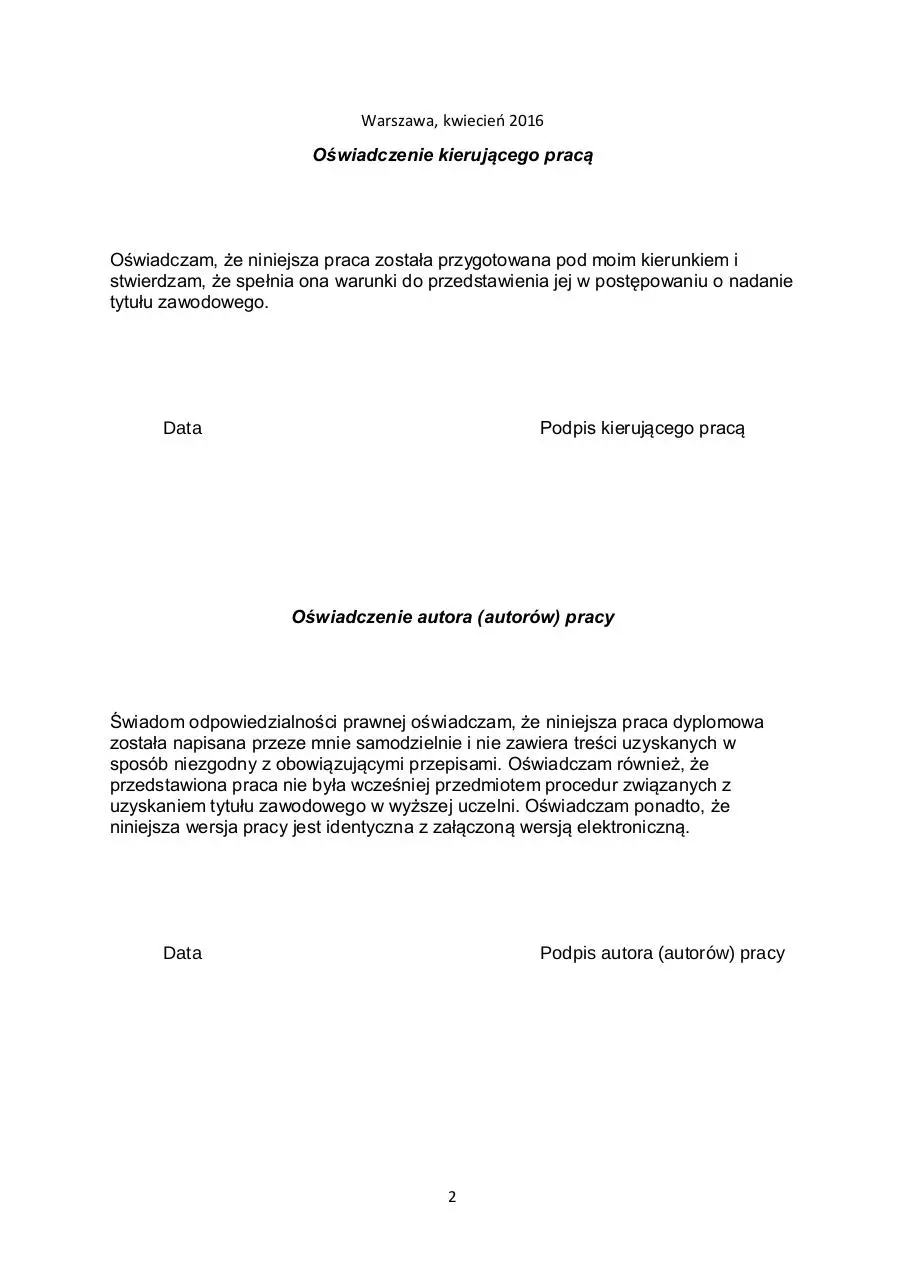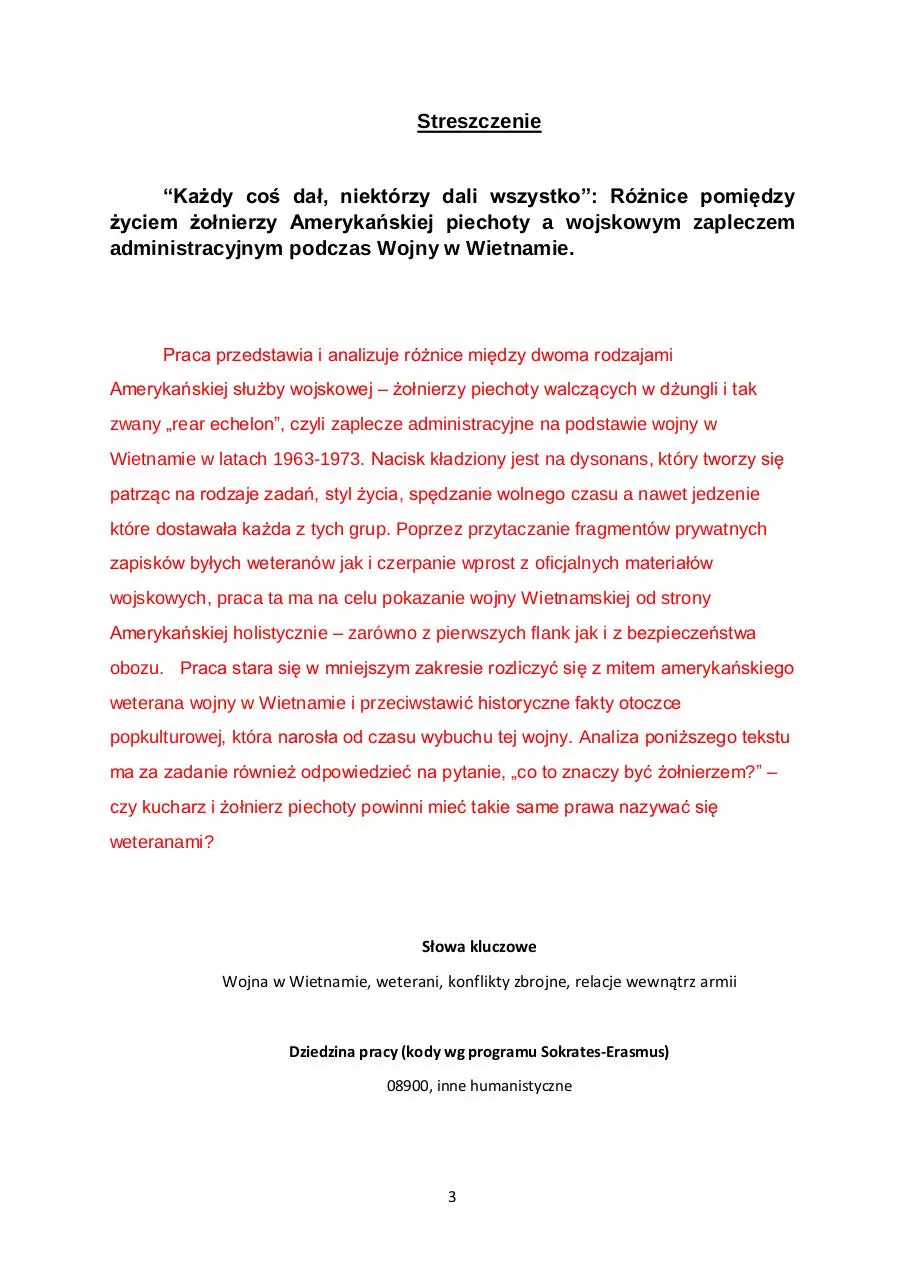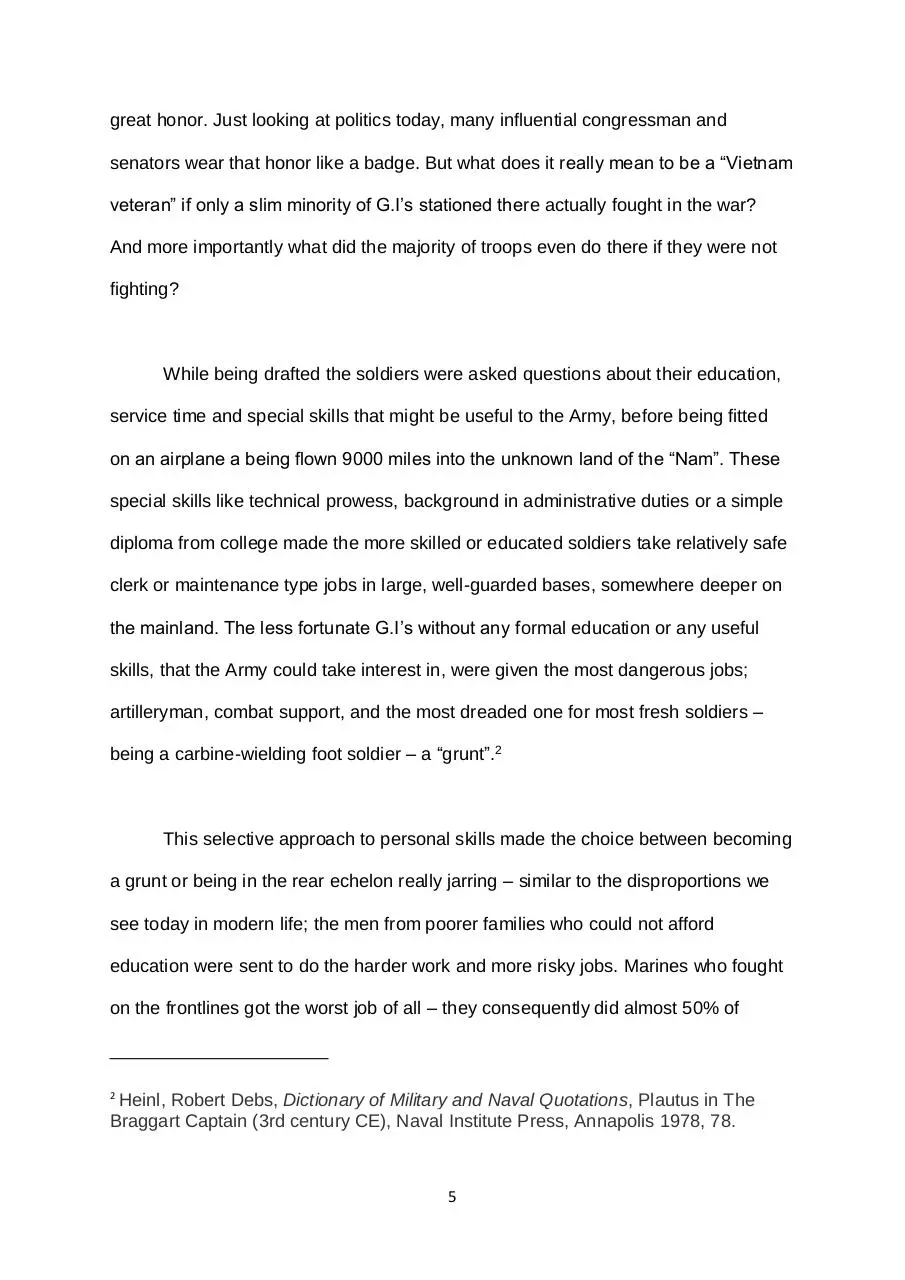4219 LICKU OSA 91040908591 (PDF)
File information
Author: Ja
This PDF 1.5 document has been generated by Microsoft® Word 2013, and has been sent on pdf-archive.com on 27/09/2016 at 23:45, from IP address 178.42.x.x.
The current document download page has been viewed 593 times.
File size: 592 KB (25 pages).
Privacy: public file





File preview
Uniwersytet Warszawski
Ośrodek Studiów Amerykańskich
Andrzej Kłosiński
Nr albumu: 307402
“All gave some, some gave all”: Differences between the life of
American foot soldiers and the rear echelon during the Vietnam
War.
Praca licencjacka
na kierunku kulturoznawstwo
w zakresie studia amerykanistyczne – kulturoznawstwo USA
Praca wykonana pod kierunkiem
Dr Zbigniewa Kwietnia
Ośrodek Studiów Amerykańskich
1
Warszawa, kwiecień 2016
Oświadczenie kierującego pracą
Oświadczam, że niniejsza praca została przygotowana pod moim kierunkiem i
stwierdzam, że spełnia ona warunki do przedstawienia jej w postępowaniu o nadanie
tytułu zawodowego.
Podpis kierującego pracą
Data
Oświadczenie autora (autorów) pracy
Świadom odpowiedzialności prawnej oświadczam, że niniejsza praca dyplomowa
została napisana przeze mnie samodzielnie i nie zawiera treści uzyskanych w
sposób niezgodny z obowiązującymi przepisami. Oświadczam również, że
przedstawiona praca nie była wcześniej przedmiotem procedur związanych z
uzyskaniem tytułu zawodowego w wyższej uczelni. Oświadczam ponadto, że
niniejsza wersja pracy jest identyczna z załączoną wersją elektroniczną.
Data
Podpis autora (autorów) pracy
2
Streszczenie
“Każdy coś dał, niektórzy dali wszystko”: Różnice pomiędzy
życiem żołnierzy Amerykańskiej piechoty a wojskowym zapleczem
administracyjnym podczas Wojny w Wietnamie.
Praca przedstawia i analizuje różnice między dwoma rodzajami
Amerykańskiej służby wojskowej – żołnierzy piechoty walczących w dżungli i tak
zwany „rear echelon”, czyli zaplecze administracyjne na podstawie wojny w
Wietnamie w latach 1963-1973. Nacisk kładziony jest na dysonans, który tworzy się
patrząc na rodzaje zadań, styl życia, spędzanie wolnego czasu a nawet jedzenie
które dostawała każda z tych grup. Poprzez przytaczanie fragmentów prywatnych
zapisków byłych weteranów jak i czerpanie wprost z oficjalnych materiałów
wojskowych, praca ta ma na celu pokazanie wojny Wietnamskiej od strony
Amerykańskiej holistycznie – zarówno z pierwszych flank jak i z bezpieczeństwa
obozu. Praca stara się w mniejszym zakresie rozliczyć się z mitem amerykańskiego
weterana wojny w Wietnamie i przeciwstawić historyczne fakty otoczce
popkulturowej, która narosła od czasu wybuchu tej wojny. Analiza poniższego tekstu
ma za zadanie również odpowiedzieć na pytanie, „co to znaczy być żołnierzem?” –
czy kucharz i żołnierz piechoty powinni mieć takie same prawa nazywać się
weteranami?
Słowa kluczowe
Wojna w Wietnamie, weterani, konflikty zbrojne, relacje wewnątrz armii
Dziedzina pracy (kody wg programu Sokrates-Erasmus)
08900, inne humanistyczne
3
“All gave some, some gave all”: Differences between the life of
American foot soldiers and the rear echelon during the Vietnam War.
Perspective is everything when talking about the Vietnam War. The facts
show us that almost 2,5 million American soldiers stationed in Vietnam between
Aug 5, 1964 and March 28, 1973, but the actual percentage of soldiers who took
active part on the battlefield throughout the war was only 10 to 15% of all stationing
troops at any given time. These percentages declined even more post-1971. It might
seem incredibly low to a layman’s eye, but this uneven combat to support role ratio
was caused by a multitude of political, social and economic reasons that divided
Vietnam War veterans and confused the public. Hopefully this paper might shed
some light on this disparity, as well as define the two types of a soldier – the rear
echelon trooper and the infantryman.1
As hard as it was for an American trooper to tell a peasant in Vietnam from a
Viet Cong soldier, every American who stationed there could distinguish the
infantryman from the rear echelon personnel. The infantrymen – or so called “grunts”
were common foot soldiers who strapped M16 carbines to their heavy backpacks
and made grueling trips through the jungle, often without rest and food and under
heavy monsoon rains. These men are immortalized in countless Hollywood movies,
such as; The Deer Hunter, Full Metal Jacket and Apocalypse Now – they seem
to be larger than life heroes, rough and charismatic with hearts full of patriotic duty.
Being a Vietnam War veteran or having someone from a family who served in it is a
1
Associeted Press. "U.S. Soldiers in Vietnam an Army of Noncombatants." New
York Times, July 1, 1972.
4
great honor. Just looking at politics today, many influential congressman and
senators wear that honor like a badge. But what does it really mean to be a “Vietnam
veteran” if only a slim minority of G.I’s stationed there actually fought in the war?
And more importantly what did the majority of troops even do there if they were not
fighting?
While being drafted the soldiers were asked questions about their education,
service time and special skills that might be useful to the Army, before being fitted
on an airplane a being flown 9000 miles into the unknown land of the “Nam”. These
special skills like technical prowess, background in administrative duties or a simple
diploma from college made the more skilled or educated soldiers take relatively safe
clerk or maintenance type jobs in large, well-guarded bases, somewhere deeper on
the mainland. The less fortunate G.I’s without any formal education or any useful
skills, that the Army could take interest in, were given the most dangerous jobs;
artilleryman, combat support, and the most dreaded one for most fresh soldiers –
being a carbine-wielding foot soldier – a “grunt”.2
This selective approach to personal skills made the choice between becoming
a grunt or being in the rear echelon really jarring – similar to the disproportions we
see today in modern life; the men from poorer families who could not afford
education were sent to do the harder work and more risky jobs. Marines who fought
on the frontlines got the worst job of all – they consequently did almost 50% of
2
Heinl, Robert Debs, Dictionary of Military and Naval Quotations, Plautus in The
Braggart Captain (3rd century CE), Naval Institute Press, Annapolis 1978, 78.
5
dying in Vietnam3 3being only a fraction of the stationed American forces there.
This economic class divide in Vietnam started as soon as the Vietnam War itself,
and was present as an underlying tone in this conflict – it pitted potential “brothers-inarms” against each other as if they were fighting a different war. Shaking the core of
what the Army represented in the minds of the soldiers – a classless structure where
merit is based on valor of soldier and not on any pre-existing life circumstances.
Many young people joined the Army to start a new life after the war, but without any
advantages such as higher class background, influence of their family or even higher
education, the soldiers in Vietnam were often on the spot categorized by their
superiors as expandable parts in the machine of war. This not only infuriated the
infantryman but also created lasting conflict between the two groups. As a result of
this politics high school dropouts were three times more likely to experience heavy
combat than college graduates.
To make things even worse between the soldiers who fought seemingly on
the same side of the same war, was that the only difference in the Army pay
structure between the grunts and the rearward personnel - the grunts earned only
$30 more than their friends in safe bases. The additional $30 was accounted on the
infantryman’s paychecks as a bonus for the hazardous conditions that they were put
into. But as it turned out, the same bonus went to rearward supply personnel such as
US Army bakery truck drivers, despite them stationing near safest, most guarded
bases near the ocean. Their job description stated that they were frequently working
out of the base which was immediately regarded as danger and warranted a
Hirschman, Charles, Casualties During the American War: A New Estimate,
Population and Development Review, December 1995, 2-11.
3
6
“hazardous conditions” paycheck which made the infantrymen confused and mad. 4
What made things even worse than the monetary compensation inequality for
frontward fighters was the living conditions that they experienced far away from
civilized American bases. To quote David Westphall, one of those G.I’s recalling his
day in the field:
We were all in sad shape now. I know that at one point, my guts about to
crack open, my stomach knotted by hunger and diarrhea, my back feeling like
a mirror made of nerves shattered in a million pieces by my flak jacket, backpack,
and extra mortars and machine gun ammo, my hands a mass of hamburger from
thorn cuts, and my face a mass of welts from mosquitoes, I desired greatly to throw
down everything and slump into the water of the paddy and sob.5
It is well known that there were many Vietnam War experiences, but after a year of
marching through the jungle with a heavy backpack killing Viet Cong soldiers, David
Westphall might be psychically scarred after returning home on US soil. Probably the
physical scarring might have been inflicted much earlier if he read some passages
from a memoir titled Saigon Zoo of his contemporary - a soldier who stationed in
Vietnam, just like David, named Pete Whalon. In this book he described being
chosen as a lifeguard and happily accepting it, as he found out it was the “ultimate
Vietnam gig” where he could host “week-long, alcohol-fuelled parties”6 and his
biggest problem was cooling off in the morning after such parties. He did just that
4
"Military Pay Chart 1968." 1968 Military Pay Chart. Accessed April 02, 2016.
https://www.navycs.com/charts/1968-military-pay-chart.html.
5
Westphall, Victor Walter. David's Story: A Casualty of Vietnam. Springer, N. Mex.:
Center for the Advancement of Human Dignity, 1981, 173.
6
Whalen, Pete. The Saigon Zoo: Vietnam's Other War: Sex, Drugs, Rock 'n Roll.
West Conshohocken, PA: Infinity Pub., 2004, 132-134.
7
by inhaling marijuana daily. The personnel that manned the rear area bases had
access to facilities, hot food and a comfortable way of living while the frontline
soldiers struggled with accepting the austere conditions of a rainforest jungle. The
general dissatisfaction that G.I.’s felt with the service was growing steadily, both
with the war and their rearward brothers-in-arms
Pete Whalon was just another lifeguard in Vietnam, but being a lifeguard in
Vietnam is just bizarre in itself. One may ask just how many swimming pools were in
American war bases in Vietnam, so that they needed lifeguards to guard grown men
swimming there? As it turns out in Long Binh Post alone, which was the base where
Whalon resided, there were twelve swimming pools7. Some 60,000 people stationed
in that base, and to house them 3,500 buildings were erected. 180 miles of concrete
was poured through jungles and hills of Vietnam to make roads for this city-sized
base. As a matter of fact, the previously noted twelve swimming pools were just the
tip of the iceberg of what the Defense Department funneled their war money into –
the rearward personnel could choose from an incredibly diverse array of ways of
spending their free time after work. The complete list of facilities from Long Binh Post
was exactly quite robust: 81 basketball courts, 64 volleyball courts, 12 swimming
pools, 8 softball fields, 8 multi-purpose courts, 6 tennis courts, 5 craft shops, 3
football fields, 3 weight rooms, 3 libraries, 2 miniature golf courses, 2 handball
court complexes, one running track, one archery, one golf driving range, one party
area, and an amphitheater in addition to BBQ pits all over the post7. And by 1972
Long Binh Post even had a go-kart track. The base was so large that some officers
even joked that the Viet Cong would have to check the bus times to properly
coordinate attack on the base.
Not only was the recreation program on bigger bases in Vietnam as elaborate
7
1st Logistical Command Magazine "Nothing Is Too Good for the Troops." , April 20,
1968.
8
as the one mentioned above, soldiers enjoyed many different distractions in their off
hours provided by their superiors. Legal alcohol consumption up to two boxes of
sixteen beers and three liters of higher percentage alcohol, like wine or whiskey. To
top that, even after purchasing their monthly supply, the G.I’s could also drink any
kind of alcohol to their hearts content in many bars and open air mess halls that were
scattered throughout the bases. Also located on the terrain of many bases were
brothels disguised as massage parlors and spas. The commanding officers
frequently knew about these kinds of shady establishments, but unlike with illegal
gambling clubs they kept their eyes shut on prostitution. They knew that sooner or
later the soldiers will start to look for those kind of services – and it was much safer
to allow some of those businesses inside the base, so the G.I.’s would not be
targeted by any unnecessary attacks outside the camps. This arrangement was so
functional that in many bases the hospital staff from American encampments
routinely did check-ups on the working Vietnamese girls to make sure that the
soldiers would not contract any diseases. In own words of a colonel who manned a
base in Phu Bai – “It is understood that steam baths have been declared nonessential, however, the essentialness of a service depends upon the availability of
other services for troop utilization. After a hot dirty day on the bunker line, the steam
bath is a welcome retreat.”8
With their free time activity well taken care of there was another very
important subject that connected all of American troopers in a way – food. No matter
if they were resting under the evergreens in the Vietnam jungle or ate in airconditioned mess halls. The food program set up by the Defense Department of the
United States was a marvel in Vietnam. It was constructed with a specific premise
that every soldier should enjoy at least one hot meal a day, irrelevant to where he
stationed. Often the soldiers marching through the jungle had to rely on their C-
8
1st Logistical Command Magazine "Nothing Is Too Good for the Troops." , April 20,
1968.
9
Download 4219-LICKU-OSA-91040908591
4219-LICKU-OSA-91040908591.pdf (PDF, 592 KB)
Download PDF
Share this file on social networks
Link to this page
Permanent link
Use the permanent link to the download page to share your document on Facebook, Twitter, LinkedIn, or directly with a contact by e-Mail, Messenger, Whatsapp, Line..
Short link
Use the short link to share your document on Twitter or by text message (SMS)
HTML Code
Copy the following HTML code to share your document on a Website or Blog
QR Code to this page

This file has been shared publicly by a user of PDF Archive.
Document ID: 0000487507.